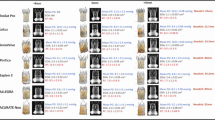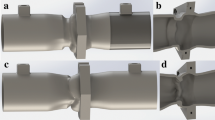Abstract
Purpose
Pre-stenting of the right ventricular outflow tract (RVOT) is commonly performed before percutaneous pulmonary valve implantation (PPVI), to relieve obstruction, prevent valved stent fractures, and provide a landing zone. This study aimed to evaluate the biomechanical characteristics of the stents currently used to perform pre-stenting of the RVOT.
Methods
We assessed five commercially available stents: Cheatham-Platinum Stent (“CP Stent”), AndraStent XL, AndraStent XXL, Optimus XL, and Optimus XXL. Following stent deployment at nominal pressure, radial and longitudinal elastic recoils and radial resistance were measured. The bending stiffness of the stents crimped onto the balloons was also evaluated.
Results
Three samples were tested for each stent. Our study showed no significant difference between the stent platforms in terms of radial elastic recoil, which was relatively low (< 10%). The longitudinal elastic recoil was also low for all the devices (< 5%). Significant differences were observed in radial resistance (P < 0.001). CP Stent and AndraStent XL exhibited the highest radial resistances. The bending stiffnesses of the stents crimped on their balloons were significantly different (P < 0.00001). Optimus XL and XXL were more flexible than the other stents.
Conclusion
This study highlights the significant differences between the stents currently used in RVOT pre-stenting. Stents with good radial resistance are preferred, especially for calcified vessels, and flexibility is crucial for tortuous vessels. We proposed an algorithm for selecting the most suitable stent according to the need for radial force and flexibility, which will help inform clinicians considering RVOT revalvulation.




Similar content being viewed by others
Data Availability
The data that support the findings of this study are available upon reasonable request.
References
Bonhoeffer, P., Y. Boudjemline, Z. Saliba, et al. Percutaneous replacement of pulmonary valve in a right-ventricle to pulmonary-artery prosthetic conduit with valve dysfunction. Lancet. 356:1403–1405, 2000. https://doi.org/10.1016/S0140-6736(00)02844-0.
Plessis, J., S. Hascoët, A. Baruteau, et al. Edwards SAPIEN transcatheter pulmonary valve implantation: results from a French registry. JACC. 11:1909–1916, 2018. https://doi.org/10.1016/j.jcin.2018.05.050.
Kenny, D., Z. M. Hijazi, S. Kar, et al. Percutaneous implantation of the Edwards SAPIEN transcatheter heart valve for conduit failure in the pulmonary position: early phase 1 results from an international multicenter clinical trial. J. Am. Coll. Cardiol. 58:2248–2256, 2011. https://doi.org/10.1016/j.jacc.2011.07.040.
Haas, N. A., A. Moysich, U. Neudorf, et al. Percutaneous implantation of the Edwards SAPIENTM pulmonic valve: initial results in the first 22 patients. Clin. Res. Cardiol. 102:119–128, 2013. https://doi.org/10.1007/s00392-012-0503-8.
McElhinney, D. B., A. C. Marshall, and S. Schievano. Fracture of cardiovascular stents in patients with congenital heart disease: theoretical and empirical considerations. Cardiovasc. Interv. 6:575–585, 2013. https://doi.org/10.1161/CIRCINTERVENTIONS.113.000148.
Cools, B., S. Brown, M. Wevers, et al. Right ventricle outflow tract prestenting: in vitro testing of rigidity and corrosion properties. Catheter. Cardiovasc. Interv. 91:285–291, 2018. https://doi.org/10.1002/ccd.27320.
Cabalka, A. K., W. E. Hellenbrand, A. Eicken, et al. Relationships among conduit type, pre-stenting, and outcomes in patients undergoing transcatheter pulmonary valve replacement in the prospective north American and European melody valve trials. JACC. 10:1746–1759, 2017. https://doi.org/10.1016/j.jcin.2017.05.022.
Peng, L. F., D. B. McElhinney, A. W. Nugent, et al. Endovascular stenting of obstructed right ventricle–to–pulmonary artery conduits: a 15-year experience. Circulation. 113:2598–2605, 2006. https://doi.org/10.1161/CIRCULATIONAHA.105.607127.
Karsenty, C., S. Malekzadeh-Milani, A. Fraisse, et al. Right ventricular outflow tract prestenting with AndraStent XXL before percutaneous pulmonary valve implantation. Arch. Cardiovasc. Dis. 113:113–120, 2020. https://doi.org/10.1016/j.acvd.2019.12.004.
Schievano, S., L. Petrini, F. Migliavacca, et al. Finite element analysis of stent deployment: understanding stent fracture in percutaneous pulmonary valve implantation. J. Interv. Cardiol. 20:546–554, 2007. https://doi.org/10.1111/j.1540-8183.2007.00294.x.
Schievano, S., A. M. Taylor, C. Capelli, et al. Patient specific finite element analysis results in more accurate prediction of stent fractures: application to percutaneous pulmonary valve implantation. J. Biomech. 43:687–693, 2010. https://doi.org/10.1016/j.jbiomech.2009.10.024.
Nordmeyer, J., S. Khambadkone, L. Coats, et al. Risk stratification, systematic classification, and anticipatory management strategies for stent fracture after percutaneous pulmonary valve implantation. Circulation. 115:1392–1397, 2007. https://doi.org/10.1161/CIRCULATIONAHA.106.674259.
Nordmeyer, J., P. Lurz, S. Khambadkone, et al. Pre-stenting with a bare metal stent before percutaneous pulmonary valve implantation: acute and 1-year outcomes. Heart. 97:118–123, 2011. https://doi.org/10.1136/hrt.2010.198382.
Haddad, R. N., D. Bonnet, I. A. Abu Zahira, et al. A new solution for stenting large right ventricular outflow tracts before transcatheter pulmonary valve replacement. Can. J. Cardiol. 38:31–40, 2022. https://doi.org/10.1016/j.cjca.2021.08.021.
Guerin, P., K. W. Fresse, and O. Razafimahatratra. Traitement percutané de la valve pulmonaire. Ann. Cardiol. Angéiol. 68:474–479, 2019. https://doi.org/10.1016/j.ancard.2019.10.003.
Mori, K., and T. Saito. Effects of stent structure on stent flexibility measurements. Ann. Biomed. Eng. 33:733–742, 2005. https://doi.org/10.1007/s10439-005-2807-6.
Jorge, C., and C. Dubois. Clinical utility of platinum chromium bare-metal stents in coronary heart disease. Med. Devices (Auckl). 8:359–367, 2015. https://doi.org/10.2147/MDER.S69415.
Houeijeh, A., C. Karsenty, N. Combes, et al. A modified technique for transcatheter pulmonary valve implantation of SAPIEN 3 valves in large right ventricular outflow tract: a matched comparison study. J. Clin. Med. 12:7656, 2023. https://doi.org/10.3390/jcm12247656.
Lim, D. S., D. Kim, J. Aboulhosn, et al. Congenital pulmonic valve dysfunction treated with SAPIEN 3 transcatheter heart valve (from the COMPASSION S3 trial). Am. J. Cardiol. 190:102–109, 2023. https://doi.org/10.1016/j.amjcard.2022.12.010.
Law, M. A., and A. Chatterjee. Transcatheter pulmonic valve implantation: techniques, current roles, and future implications. World J. Cardiol. 13:117–129, 2021. https://doi.org/10.4330/wjc.v13.i5.117.
Sivakumar, K., P. Sagar, S. Qureshi, et al. Outcomes of Venus P-valve for dysfunctional right ventricular outflow tracts from Indian Venus P-valve database. Ann. Pediatr. Cardiol. 14:281–292, 2021. https://doi.org/10.4103/apc.APC_175_20.
Sivaprakasam, M. C., J. R. V. Reddy, S. Gunasekaran, et al. Early multicenter experience of a new balloon expandable MyVal transcatheter heart valve in dysfunctional stenosed right ventricular outflow tract conduits. Ann. Pediatr. Cardiol. 14:293–301, 2021. https://doi.org/10.4103/apc.apc_242_20.
Funding
Not applicable.
Author information
Authors and Affiliations
Corresponding author
Ethics declarations
Conflict of interest
The authors declare no conflict of interest.
Additional information
Associate Editor Jamshid Karimov oversaw the review of this article.
Publisher's Note
Springer Nature remains neutral with regard to jurisdictional claims in published maps and institutional affiliations.
Supplementary Information
Below is the link to the electronic supplementary material.
SuppFig1.
Longitudinal elastic recoil (TIFF 169 kb)
Rights and permissions
Springer Nature or its licensor (e.g. a society or other partner) holds exclusive rights to this article under a publishing agreement with the author(s) or other rightsholder(s); author self-archiving of the accepted manuscript version of this article is solely governed by the terms of such publishing agreement and applicable law.
About this article
Cite this article
Piriou, PG., Plessis, J., Manigold, T. et al. Standardized Bench Test Evaluation of Biomechanical Characteristics of Stents Used in Right Ventricular Outflow Tract Revalvulation. Cardiovasc Eng Tech (2024). https://doi.org/10.1007/s13239-024-00726-1
Received:
Accepted:
Published:
DOI: https://doi.org/10.1007/s13239-024-00726-1




